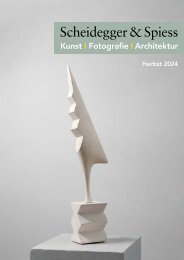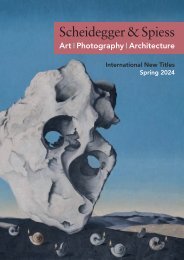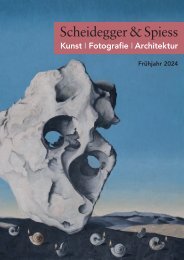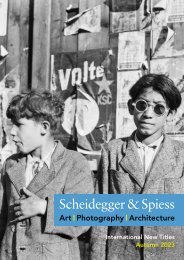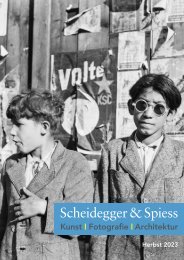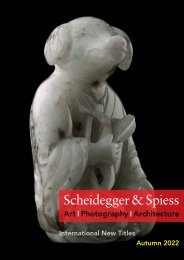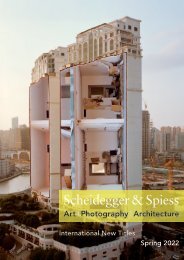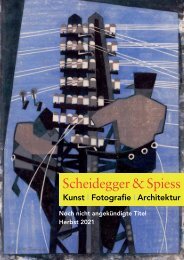Vorschau Scheidegger & Spiess Fruehjahr 2020
Das aktuelle Frühjahrsprogramm mit den Neuerscheinungen des Verlags Scheidegger & Spiess im Bereich Kunst, Fotografie und Architektur!
Das aktuelle Frühjahrsprogramm mit den Neuerscheinungen des Verlags Scheidegger & Spiess im Bereich Kunst, Fotografie und Architektur!
Erfolgreiche ePaper selbst erstellen
Machen Sie aus Ihren PDF Publikationen ein blätterbares Flipbook mit unserer einzigartigen Google optimierten e-Paper Software.
“The furniture is to serve as a simplified set
for different performances. Figure 1 shows
a chair, its sides made up of two frames
joined by two hinges that are also attached
to the seat. The chair can be folded when
required; the sides fold in and the seat lifts
up against the back of the chair. When
folded the chair is flat, making it easy to
transport when the theatre is on tour and
when there are a number of chairs on stage,
usually a small stage, they can be folded
and stored in the wings, thus saving space.
Figures 4 and 5 show possible combinations
for the folding chair: a sofa, carriage seat,
etc. If required, the shape of the chair can
be changed or given a particular style; a
canvas cover can be sewn to fit the chair,
and then painted in a particular style to give
it a different appearance or character, as
shown in Figure 2. Figures 6 and 7 show
stool covers painted in a variety of ways.
Figure 8 shows the transformation of the
table into an orator’s podium. The table is
made in the same way as the chair, with two
side frames that fold inwards, and crosswise
folding frames fixed with loops on the upper
horizontal bars of the main frame of the
table. The crosswise hinged frames assume
the position shown by the dotted lines when
the table is required, whilst when the podium
is required, they assume the position
indicated in the drawing (a bar fastening on
one side). The table top is made separately.
In order to climb up to the podium there is
a small set of steps attached at one side of
the table.” 59
Museum of history of the city of Sochi.
(MOMus, Thessaloniki).
Schusev State Museum of Architecture.
The complex consisted of 3 separate
buildings: a 6-storey building
with residential individual “cells” for
one person, a 7-storey building with
2-3 room apartments for families and
a communal unit with the laundry
room, gym and public canteen. On
the roofs of the 1st and 2nd buildings,
connected by a bridge-crossing,
it was planned to place the solariums
and playschool.
Schusev State Museum of Architecture.
Suprematism I arkhitektura.
(Suprematism and Architecture). 2007.
Schusev State Museum of
Architecture collection.
PROPAGANDA FURNITURE
Khleba Kommunizma
(Breads of Communism).
The furniture set Breads of Communim
was created for Mikhail Kalinin
housing commune in the city of
Smolensk by Igor Krestovsky, the
prominent sculptor and professor at
the Academy of Fine Arts in Leningrad
(now Saint-Petersburg). The creation
of housing commune was a unique
architectural and social movement
in the Soviet Union of the 1920s -
1930s, which displayed a new fashion
of collective living, propagated by
French philosopher Charles Fourier.
The apartments of the Mikhail Kalinin
housing commune in Smolensk were
assigned to department officers of
the Academy of Agriculture, which
determined the title of the furniture
group as Khleba Kommunizma (Breads
of Communism). The furniture
created for the public areas of
communal houses are almost totally
lost, thus the set of furniture Khleba
Kommunizma is considered to be the
only full surviving set of such interiors.
Private collection
HOUSING COMMUNES
by Elizaveta Likhacheva
&
“ COMMUNA 33 ” — a
compact multifuctional flat
by Studio Bazi.
Zone of the living room.
Museum of Modern Art – Costakis
collection (MOMus, Thessaloniki).
State Museum of Architecture collection.
Arkhitektura SSSR (Architecture of
USSR) Magazine No. 11. 1976.
The oak block contains kitchen, hidden
behind folding doors and a wardrobe
with washing machine and cleaning
storage. A curtain embedded in this
block separates the bedroom and
bathroom from the living zone making
them more cosy and private.
A round window in the small
bathroom gives a view to the street
making it more open.
Built-in wardrobe, integrated
From the book of Selim Khan-
Magomedov Suprematism i arkhitektura.
(Suprematism and Architecture). 2007.
State Museum of Architecture collection.
TASS photographic archive.
were developing. It valued the “supremacy of pure artistic
feeling” over the visual depiction of objects. Constructivists
such as Nikolai Suetin and a number of other industrial
artists borrowed little from Suprematism’s theory, but
they adapted its visual motifs in their furniture projects:
its characteristic patterns, simple geometry of forms and
spatial organization. Occasionally this resulted in rather
basic interpretations of Suprematism in simple household
objects, such as decorative furniture covers made of fabrics
whose patterns were based on Suprematist paintings.
Futurism, with its origins in Italy, Cubism (mostly its
painting and sculpture) and other artistic currents of the
early 20th century also had considerable influence on the
formation of Constructivism.
In 1925, members of the creative association LEF (Left
Front of the Arts) set up the official creative organization
of Constructivists, OSA (Organization of Modern Architects);
its members included Alexander Rodchenko, Varvara
Stepanova, Kazimir Malevich, the Vesnin brothers,
Ivan Leonidov, Moisei Ginzburg, and others. OSA members
developed a functional design method based on the
scientific analysis of how structures worked. 6
The stellar roll-call of OSA members and the uniqueness
of the projects developed under its banner guaranteed
OSA an important role in the development of Soviet and
international design. The ideas of these avant-garde artists
influenced art throughout the 20th century, and their
importance continues today.
1920 is generally regarded as the year when the first advocates
of Constructivism began their search for new art
forms. Central to the movement was the idea of abandoning
the “metaphysical essence of idealistic aesthet-
LYUBOV POPOVA.
Fabric Design Sketch. Ca. 1923–1924.
Museum of Modern Art – Costakis collection
11
by their immediate purpose, with no element performing a purely decorative
function. The planners worked with the form of the object as though it were
a mechanism to serve the user.
One may conclude that furniture projects became more utilitarian as planners
moved further away from the realm of art; their expressive qualities came to
depend more on the construction and technical connection between their
parts than on either their aesthetic correlation or their colour and tonal combinations.
Therefore, it makes sense to reflect on the work of the avant-garde figures through
both the prism of art and function. In this context, art should be understood as the
sphere of experiment, the search for new forms, with no utilitarian goals at its foundation,
whereas function is always about the utilitarian, the serial and the mass.
Large Coffee Pot. 1923.
Painting on porcelain according to
the design project of Nikolai Suetin.
State Porcelain Factory, Petrograd.
42
1. FURNITURE AS ART
The artist-planners who designed furniture and interiors
in the 1920s had more artistic skill than technical
mastery. In their works, utilitarian purpose and functional
development were superseded by experiments
with form and the search for the new.
Nikolai Suetin, a student of Kazimir Malevich, is known
primarily as an outstanding master of artistic porcelain,
but his interests as an artist extended much further. He
developed his own language of design, notable for its focus
on the correlation of shapes and on the harmony of
tone and colour among them. Suetin looked for forms and
new solutions for his furniture projects; in his drawings
and draughts, he solved issues more closely related to art
than to engineering and construction. His sketches reference
the Suprematist works and sculptural architectonics
of his teacher Malevich. Interestingly, the coffin in which
Malevich was buried in 1935 was made after drawings
by Suetin; it took the form of a Suprematist architecton.
Unlike many students and teachers at VKhUTEMAS–
VKhUTEIN, who concentrated on the interaction of form
and function in the object, Suetin pursued a more formal
and decorative approach in his projects.
Alexander Rodchenko, one of the masters of the Soviet
avant-garde, is known above all for his photography and
graphic accomplishments. His work had a huge impact on
the formation of new ideas in art and design, but his pivotal
role in Soviet furniture design is much less well known.
Working with Varvara Stepanova, Rodchenko carried out
a ground-breaking experiment with the creation of expressionist
stage sets for the Meyerhold Theatre production
of Tarelkin’s Death. The play was the third in a trilogy
NIKOLAI SUETIN.
Project of an armchair. 1927.
43
ics”. 7 The Constructivists were determined to give all art
by Alexander Sukhovo-Kobylin. Written in 1869, it made
a material purpose and they set themselves the following
a mockery of tsarist bureaucracy and became an iconic
tasks: the destruction of abstract and old forms of art and
production when staged by Vsevolod Meyerhold in 1922.
the development of a rational structure of the artwork.
Theatrical stage props constitute a completely separate
Their programme, written by Alexei Gan, was presented
sphere of furniture design. Because they are designed as
on 1 April 1921 at the plenary session of the GINKhUK
part of the set for a particular performance, their form
50 51
86 87
\
\
Communa 33 flat. Kitchen unit.
85
KONSTANTIN MELNIKOV
and V. KUROCHKIN.
Gosplan garage in Moscow (1934-1936).
Photograph late 1930s.
74
Communa 33 flat.
Zone of the living room. 83
Communa 33 flat. Bedroom.
86
different piece, with different visual characteristics; but the person who sits on
it still uses it as a chair—in other words, still uses it for its designated purpose.
A comparison of these two projects, which were created in the same year,
shows that a number of different concepts coexisted and interacted with one
another in furniture design of the 1920s. On the one hand, both Suetin and
Morozov emphasized the construction of the object, but on the other, they
used different techniques to the same end. In the case of Suetin’s suite, for-
Communa 33 flat.
84
View on the stairs.
mal function matters—that is, the various parts of the object are held together
by their colour and shape, which are determined by their function,
but their proportions are based more on the compositional-decorative idea
than on constructive need. On the contrary, with Morozov’s table construction
takes precedence over form: the transforming structure is dictated by
its technical requirements and consists of many constructional intricacies.
The concepts behind these two projects can be seen as the two poles of Soviet
furniture design of the 1920s to the beginning of the 1930s, and it was by
oscillating between the two that the search for new furniture forms would
continue: from Suprematism’s expressionist approach to object design to
Constructivism and Rationalism.
MIKHAIL BARSHCH, IGNATY MILINIS,
VLADIMIR VLADIMIROV, MIKHAIL
SINYAVSKY, ALEXANDER PASTERNAK, S.
V. ORLOVSKY, LYUBOV SLAVINA.
Project of the housing commune on Gogolevsky
Boulevard in Moscow (1929-1931).
75
Communa 33 flat.
87
under the stairs.
114 115
122 123
\
EL LISSITZKY (Lazar Lisitsky).
The “combination furniture”. 1929. From
the book of Selim Khan-Magomedov
102
also be effectively adapted for everyday life, whereby
individual objects in different combinations performed
various functions. El Lissitzky’s “combination furniture”,
for example, was derived from a similar conceptual
approach, as were different furniture projects by various
designers of the 1930s right through to the 1980s.
I. Lobov’s model for a cabinet-display case for displaying
and keeping books and illustrated magazines and brochures
fits into the categories of both furniture and exhibition
equipment. The Red Niva magazine supplement
again published a detailed description of this piece:
The club cabinet-cum-display case is mostly intended
for books. The upper part of the cabinet comprises four
shelves designed to hold 200 books. The double doors are
to be used for the display of photographs or photo-montages,
which can be inserted on two different planes on
both sides of the doors. The first is attached with hinges to
the body, while the second is inserted in slots into the first:
MOISEI GINZBURG,
IGNATY MILINIS.
Residential house on
Novinsky Boulevard in
Moscow (Narkomfin House,
1928-1930). Architectural
Model of N. A. Yunusov, 1988.
103
Vom Konstruktivismus über
Art déco zurück zu Avantgarde
und Bauhaus: Das sowjetische
Design wandelte sich im Takt
der Zeit
136
137
VLADIMIR MESHCHERIN.
Sketch of an armchair for
the twin-hulled catamaran
hydroplane Express
(OSGA-25). 1937
180
S. AIRAPETOV, V. UTKIN, K.
SHEKHOYAN, S. TIKHOMIROV, O.
VELIKORETSKY.
Interior of the Berezka store in Moscow.
Photograph by Mikhail Churakov, 1962.
276
for the hydroplane had different forms: some were very
dynamic in appearance, their frames made from curved
lines of tubular metal that seemed to bend as it rose along
the seat and its back, simultaneously creating a feeling of
Twin-hulled catamaran hydroplane
Express (OSGA-25). Exterior and
Interior. Sochi, 1930s.
182
safety and security. 25
are smooth and the suspended tables of the sideboard, with their expressive
ceiling fastenings, resemble the natural organic forms of plants. The
table-top is suspended on a cylindrical rod fixed to a point on the floor and
attached to the ceiling; this allows for a significant increase in the usable area
of the cabin and facilitates the easy movement of passengers and the rearrangement
of the seats. The look of the fittings is complemented by the shiny
material used for the wide cylindrical supports and table-tops. The chairs
During the construction of the watercraft, limited serial
production was set up for individual elements—chairs,
tables, windows, and the stylish hooks and handles inspired
by the teardrop shape of the vessel’s own aerodynamic
silhouette. To create these elements, a volumetric
method of moulding from metal or plastic was used, a
production technique not yet widely used in the field of
transportation.
The hydroplane ran the passenger line between Yalta
VLADIMIR MESHCHERIN.
Sketches of interiors for the twinhulled
catamaran hydroplane
Express (OSGA-25). Sochi. 1937.
181
and Sevastopol in the Crimea, and also made regular
trips on the high-speed line from Sochi to Sukhumi on
the Black Sea. It could carry up to 150 passengers at a
speed of 80 km/hour.26 It was destroyed in 1941, during
the German occupation of Odessa.
The furniture of the 1930s made far greater use of the
expressive characteristics of metal, responding both to
fashion and developments in industry, while Western Art
Deco used a great many glass and metallic elements. In
the decade, mass-production furniture developed very
slowly; production was more often undertaken as limited
quantity serial orders or as single items.
A. ANISIMOV, A. KONSTANTINOV, M.
BASKAEV, M. KUTSEVOL, N. ORLOVA.
Interior of Aelita cafe at Oruzheiny Lane in
Moscow. Photograph by Alexey Alexandrov, 1961.
277
220 221
306 307
\
ALEXANDER SHIPKOV.
Interior project of t
wo-level apartment.
303
tion, which had been such a feature of the tapered-leg
furniture of the 1950s and ’60s, completely disappeared.
As part of its developing international relations, the Soviet
Union in the 1970s began to export an array of goods
to socialist bloc countries and Western Europe (Zenit
cameras, various wrist watches such as the Glory, Flight,
Ray and Rocket, VEF radios, Zil refrigerators, Moskva
and Lada cars). Furniture, however, was not suited to the
export market—on the contrary, it was imported in large
quantities from the countries of Eastern Europe.
A landmark event was the foundation in 1987, on the initiative
of Yuri Solovyev, of the Union of Designers. The
A set of new upholstered
furniture. Estonian SSR Tallinn
Research and Production
Furniture Association
“Standard”. Photograph by Endel
Tarkpea, 1976.
304
taboo, which had lasted so many years, against the very
word “design”, was finally lifted. Designers were now given
the opportunity to open their own studios and to work
the hours they wanted. 29 This undoubtedly encouraged
greater freedom of expression, despite the Union of Designers’
position as a State organization under the auspices
of Gosplan. By the end of the 1980s, there were around
IGOR KRESTOVSKY.
Sketches for Khleba Kommunizma (Breads
of Communism) furniture set. 1937.
187
eighty individual studios in the USSR. The inauguration
of the Union of Designers had little direct effect on furniture
production in the USSR, but it was undoubtedly very
significant in a broader sense, because it stimulated the
growth of individual project designs that were not aimed
226 227
334 335



